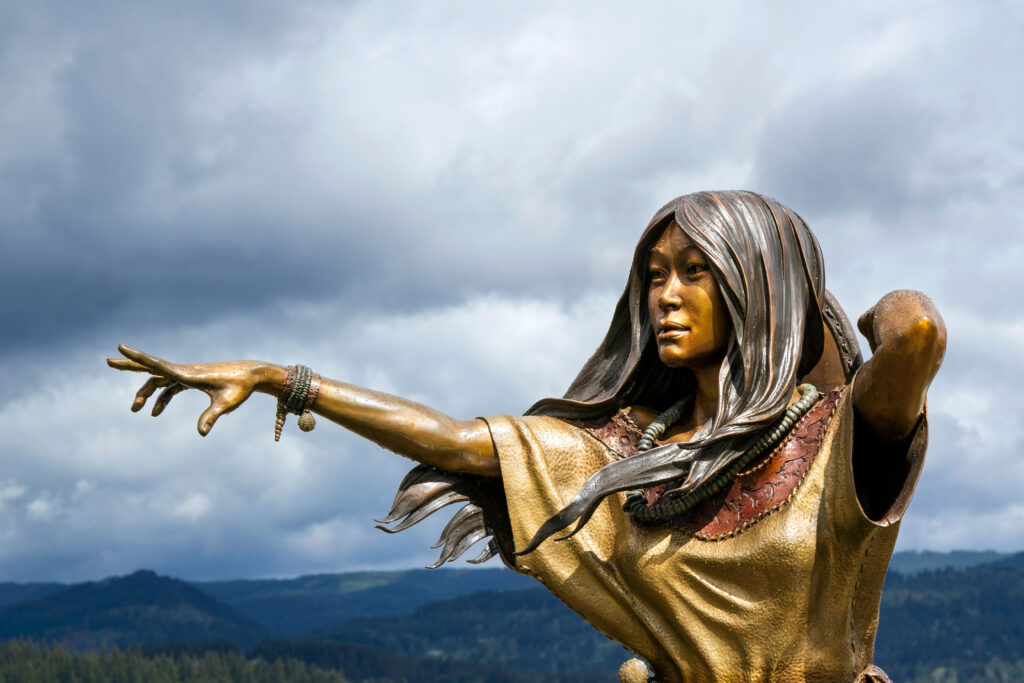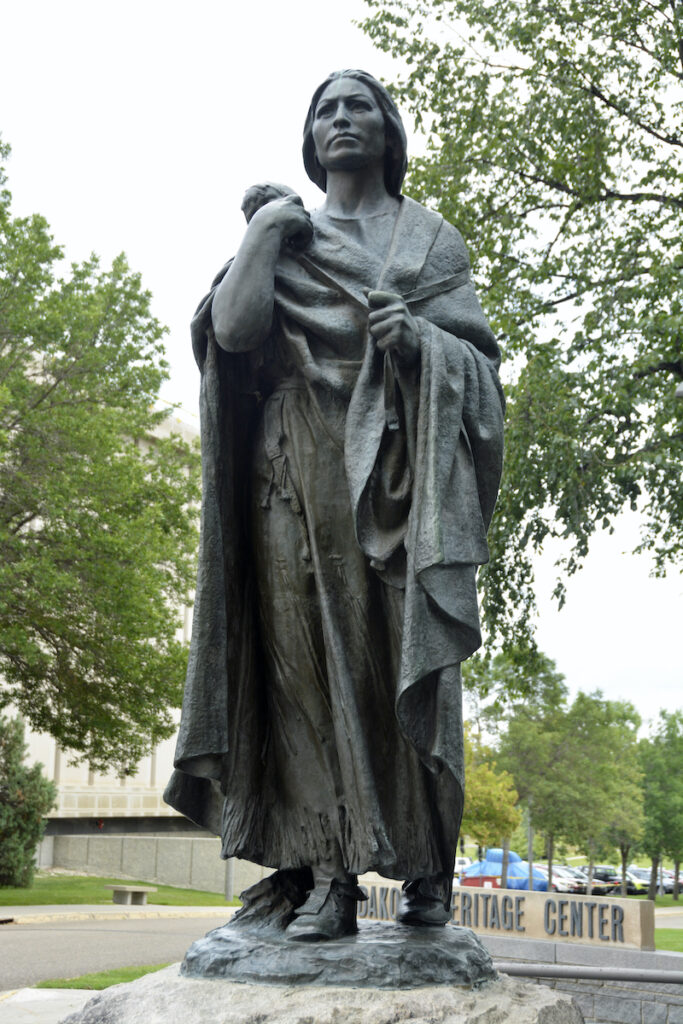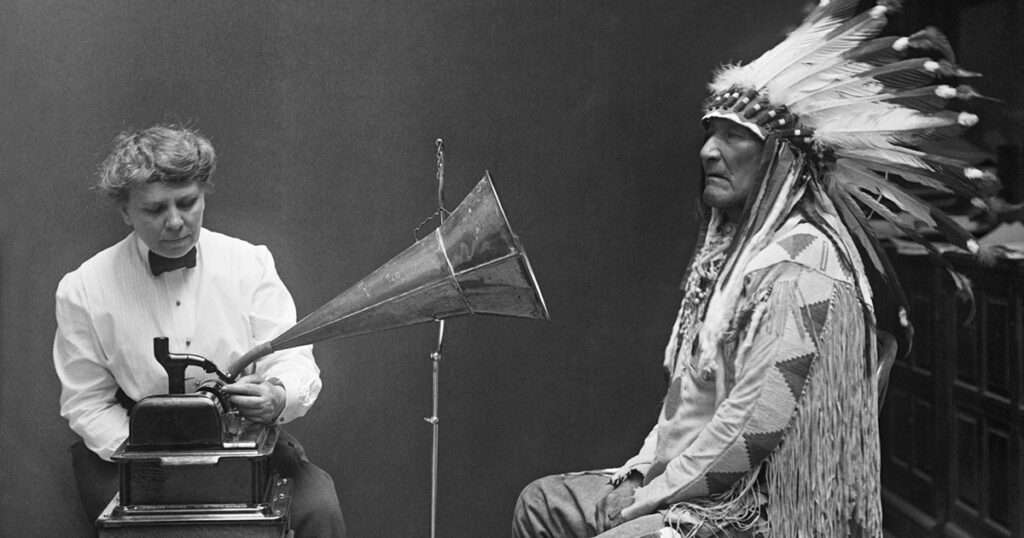
I’ve spent much of my life studying and thinking about the Lewis and Clark Expedition. I’ve portrayed Meriwether Lewis, been part of several documentary films on the subject, edited the journals of the expedition for the North Dakota phases (A Vast and Open Plain: The Writings of the Lewis and Clark Expedition in North Dakota, 1804-1806), and written a serious book about the character of Meriwether Lewis.
You cannot think about the Lewis and Clark story without trying to come to terms with Sacagawea.
She is the most statued woman in American history. And she is one of the two most prominent Native American women in American memory.
And yet, to borrow Winston Churchill’s famous description of the Soviet Union, “she is a riddle, wrapped in a mystery, inside an enigma.” We think we know her, know about her, but most of what we think we know belongs more to mythology, fantasy, speculation, and even fiction than to rigorous history. How can it be that Anna Lee Waldo wrote a 1,359-page book about Sacagawea and yet what we actually know about her would not fill a passport book?
Recently I made a list of the significant references to Sacagawea in all of the million-plus words of the journals of Lewis and Clark. The list is thin gruel. She dug up some roots and collected some berries along the way. She was still nursing her son Jean Baptiste Charbonneau at the end of the expedition. By now he was eighteen months old. She put her foot down in Oregon when a group of the men were heading to the coast to see a beached whale, saying that she had crossed the continent and was not going to be left behind now when they were heading to see the monstrous fish. She pointed the way through Bozeman Pass for Clark on the return journey. She played a role — how significant we don’t know — in obtaining horses for the expedition from her natal people the Lemhi Shoshone.
She left no journal. The whale incident is the only instance of something like a real Sacagawea quotation:
The last evening Shabono and his Indian woman was very impatient to be permitted to go with me, and was therefore indulged; She observed that She had traveled a long way with us to See the great waters, and that now that monstrous fish was also to be Seen, She thought it verry hard that She Could not be permitted to See either (She had never yet been to the Ocian).
Clark, January 6, 1806
Such oral traditions as have emerged, principally among the Shoshone and the Hidatsa, are hard to reconcile with the facts as they were recorded by Meriwether Lewis on May 20, 1805, when he named a river for her in eastern Montana and reported her life story (she was only 17 or 18) as he heard it through somewhat imperfect translation.
We don’t know for certain when she was born (or maybe where). We don’t know for certain when she died (or where). We are not even 100% sure of her tribal identity. She appears to have been born Shoshone, but she was captured by the Hidatsa (we think) when she was around 11 or 12-years-old near Three Forks, Montana, and taken 580 miles east to the Knife River earth lodge villages of the Hidatsa. By the time Lewis and Clark met her on November 4, 1804, she had been acculturated into the Hidatsa world (we think). You can get into an argument, maybe a shouting match, about all of this at any Lewis and Clark event, especially in Idaho.
So, who was she then? What does she signify? How can we make sense of her, given that almost all we know or think we know about her comes from official U.S. Army records written by busy white men on an imperial mission who were carrying around a good deal of Eurocentric and male-centric baggage about Native Americans, women, and the West?
All those statues are scattered around the country. In Portland she is pointing the way to Asia. In Charlottesville she was (the statue has been removed) crouching behind William Clark as if needing the two captains for protection. On the 2000-2008 U.S. dollar coin she is confident and comely, perhaps a little bemused, looking back at us as if interrupted in her own journey. At Cascade Locks in Oregon she is lithe with an erotic allure, a kind of white male’s fantasy of Miss Indian America 1805.

By far my favorite statue of Sacagawea stands proud on the grounds of the state capitol in Bismarck, North Dakota. It was sculpted by Leonard Crunelle just after the centennial of the Lewis and Clark Expedition. His model was a Hidatsa woman, perhaps a descendant, named Mink (also known as Hannah Levings Grant). Crunelle’s Sacagawea is tall, proud, and independent. She is wearing a full-length deerskin dress. Her infant Jean Baptiste Charbonneau is on her back, cradled in a shawl. Sacagawea has a blanket or robe over her right arm. Her hair hangs loosely over her upper back.
The journals of Lewis and Clark tell us nothing about Sacagawea’s physique. We don’t know if she was tall or short, lean or not, beautiful or otherwise — and who decides what is beautiful across cultures or even in our own? We don’t know if she ever laughed or ever cried. We don’t know if she stayed on the periphery or integrated herself into the Corps of Discovery. But when I close my eyes and think about Sacagawea, I see Crunelle’s strong woman standing tall. She is not fussing over her baby, but she is taking good care of him, with one arm checking on his status in the cradle shawl.
I’ve taken scores of photographs of the Crunelle statue over the years, but it is very difficult to do it justice on its pedestal on the capitol grounds. It tends either to silhouette out against the sky, or lose its clear sculptural lines against the trees in the background, both in the summer when the leaves are flourishing or in the long winter when the branches are what Shakespeare called “bared ruined choirs” against the leaden skies.
Can we get any closer to the historical Sacagawea?
David Swenson of Makoche Recording Studio in Bismarck directed audio recordings of a contemporary young Hidatsa woman singing a traditional corn song that was also recorded a hundred years ago on a cylinder disk by Frances Densmore (1867-1957), a brilliant ethnomusicologist from Minnesota. Even though the contemporary Hidatsa woman did not know quite what she was singing, it dovetailed beautifully with the Densmore recording. If Densmore recorded that song around 1912, sung by an elderly Hidatsa woman named Scattered Corn, it is at least remotely possible that Scattered Corn was a little girl when Sacagawea was still living at the earth lodge villages near the mouth of the Knife River. Probably not, but the resonance (the musical echo and fidelity) of the Hidatsa oral song tradition is so remarkable that it is certainly possible that Sacagawea heard (or sang!) that song or a variant of it when she was tending the Hidatsa corn plots in the bottomlands of the Missouri. When I first heard David tell that story, it made the hair on my arms stand up.

That is probably as close as we are likely to get to Sacagawea.
My friend Shane Balkowitsch of Bismarck took up collodion wet glass plate photography about a decade ago. Once he mastered the difficult technique, which was the best photo technology between ca. 1855-1880, he began to make portraits of Native Americans. He has now taken photographs of 718 individuals. His goal is to take at least 1,000 portraits, perhaps more. A few weeks ago I called Shane to ask him if he would be willing to take a photograph of the Crunelle statue. He jumped at the chance. The statue was unveiled in October 1910, just over 100 years after the Lewis and Clark Expedition. With wet plate technology dating back to the 1850s, I wanted the photographic technique to get as close to the life of Sacagawea as possible.
I’ve walked many times around the Knife River village where Sacagawea lived in the years before Lewis and Clark showed up out of nowhere. I’ve lain in several of the depressions left by the earth lodges that have long since disappeared. I’ve kicked up glass seed beads there that date to the early and mid-19th century. I’ve met Hidatsa women who can pronounce Sah-cah-gar-we-a’s name in ways that I could never emulate. I’ve been to Lower Portage Camp where she nearly died of some gynecological infection in late June 1805 and to the sulphur spring where Lewis obtained mineral water that he hoped might save her life. I’ve read every book I can get my hands on about what little we know of her life. I have written extensively about her, attempted to imagine her countless times, and puzzled over every journal entry that pertains to her as if I were studying the Kabballah.
But for all of that, despite Scatter Corn’s scratchy and airy song, and Shane’s attempt to match time and technique, Sacagawea remains a mystery, wrapped in a riddle, and definitely an enigma. We continue to colonize her for our historical memory, and we construct her from such small fragments as we have.
